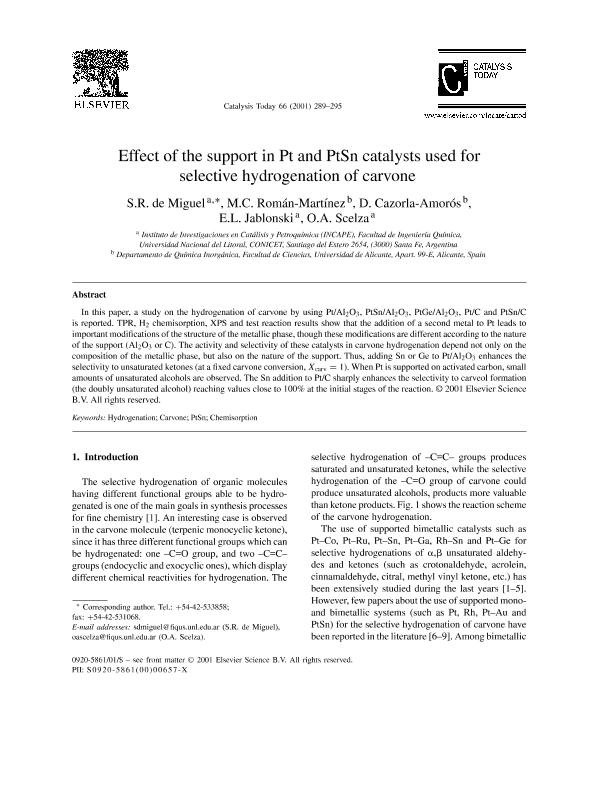Mostrar el registro sencillo del ítem
dc.contributor.author
de Miguel, Sergio Ruben

dc.contributor.author
Román Martinez, M.C.
dc.contributor.author
Cazorla Amorós, Diego

dc.contributor.author
Jablonski, Estanislao Lorenzo

dc.contributor.author
Scelza, Osvaldo Antonio

dc.date.available
2018-03-20T15:58:24Z
dc.date.issued
2001-03
dc.identifier.citation
de Miguel, Sergio Ruben; Román Martinez, M.C.; Cazorla Amorós, Diego; Jablonski, Estanislao Lorenzo; Scelza, Osvaldo Antonio; Effect of the support in Pt and PtSn catalysts used for selective hydrogenation of carvone; Elsevier Science; Catalysis Today; 66; 2-4; 3-2001; 289-295
dc.identifier.issn
0920-5861
dc.identifier.uri
http://hdl.handle.net/11336/39344
dc.description.abstract
In this paper, a study on the hydrogenation of carvone by using Pt/Al2O3, PtSn/Al2O3, PtGe/Al2O3, Pt/C and PtSn/C is reported. TPR, H2 chemisorption, XPS and test reaction results show that the addition of a second metal to Pt leads to important modifications of the structure of the metallic phase, though these modifications are different according to the nature of the support (Al2O3 or C). The activity and selectivity of these catalysts in carvone hydrogenation depend not only on the composition of the metallic phase, but also on the nature of the support. Thus, adding Sn or Ge to Pt/Al2O3 enhances the selectivity to unsaturated ketones (at a fixed carvone conversion, Xcarv = 1). When Pt is supported on activated carbon, small amounts of unsaturated alcohols are observed. The Sn addition to Pt/C sharply enhances the selectivity to carveol formation (the doubly unsaturated alcohol) reaching values close to 100% at the initial stages of the reaction. © 2001 Elsevier Science B.V.
dc.format
application/pdf
dc.language.iso
eng
dc.publisher
Elsevier Science

dc.rights
info:eu-repo/semantics/openAccess
dc.rights.uri
https://creativecommons.org/licenses/by-nc-sa/2.5/ar/
dc.subject
Carvone
dc.subject
Chemisorption
dc.subject
Hydrogenation
dc.subject
Ptsn
dc.subject.classification
Otras Ingeniería Química

dc.subject.classification
Ingeniería Química

dc.subject.classification
INGENIERÍAS Y TECNOLOGÍAS

dc.title
Effect of the support in Pt and PtSn catalysts used for selective hydrogenation of carvone
dc.type
info:eu-repo/semantics/article
dc.type
info:ar-repo/semantics/artículo
dc.type
info:eu-repo/semantics/publishedVersion
dc.date.updated
2018-03-16T15:40:52Z
dc.journal.volume
66
dc.journal.number
2-4
dc.journal.pagination
289-295
dc.journal.pais
Países Bajos

dc.journal.ciudad
Amsterdam
dc.description.fil
Fil: de Miguel, Sergio Ruben. Consejo Nacional de Investigaciones Científicas y Técnicas. Centro Científico Tecnológico Conicet - Santa Fe. Instituto de Investigaciones en Catálisis y Petroquímica "Ing. José Miguel Parera". Universidad Nacional del Litoral. Instituto de Investigaciones en Catálisis y Petroquímica "Ing. José Miguel Parera"; Argentina
dc.description.fil
Fil: Román Martinez, M.C.. Universidad de Alicante; España
dc.description.fil
Fil: Cazorla Amorós, Diego. Universidad de Alicante; España
dc.description.fil
Fil: Jablonski, Estanislao Lorenzo. Consejo Nacional de Investigaciones Científicas y Técnicas. Centro Científico Tecnológico Conicet - Santa Fe. Instituto de Investigaciones en Catálisis y Petroquímica "Ing. José Miguel Parera". Universidad Nacional del Litoral. Instituto de Investigaciones en Catálisis y Petroquímica "Ing. José Miguel Parera"; Argentina
dc.description.fil
Fil: Scelza, Osvaldo Antonio. Consejo Nacional de Investigaciones Científicas y Técnicas. Centro Científico Tecnológico Conicet - Santa Fe. Instituto de Investigaciones en Catálisis y Petroquímica "Ing. José Miguel Parera". Universidad Nacional del Litoral. Instituto de Investigaciones en Catálisis y Petroquímica "Ing. José Miguel Parera"; Argentina
dc.journal.title
Catalysis Today

dc.relation.alternativeid
info:eu-repo/semantics/altIdentifier/doi/https://doi.org/10.1016/S0920-5861(00)00657-X
dc.relation.alternativeid
info:eu-repo/semantics/altIdentifier/url/https://www.sciencedirect.com/science/article/pii/S092058610000657
Archivos asociados
